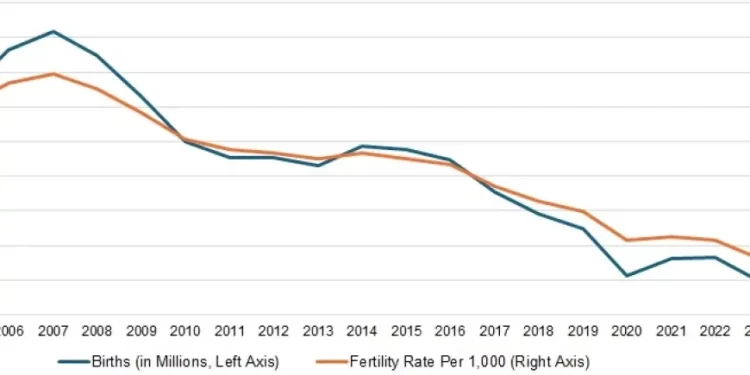The Facilities for Illness Management (CDC) launched provisional data on the variety of births for 2024. After hitting a document low in 2023, the final fertility fee—or the variety of births per 1,000 girls aged 15 to 44—rose 0.7% in 2024. An estimated 3,622,673 births have been recorded in 2024, up from 3,596,017 in 2023. For context, there have been 4.1 million births in 2004, when the fertility fee stood at 66.1%.
The whole fertility fee—which displays the common variety of youngsters a girl is anticipated to have over her lifetime—additionally ticked up, rising 0.6% from 1.6165 in 2023 to 1.6265 in 2024.

Nevertheless, because the CDC notes, the entire fertility fee stays nicely under the substitute stage of two.1, or the edge at which a technology can maintain its inhabitants. This underscores why demographic developments will pose long-term challenges for the U.S. within the years forward.
The Congressional Price range Workplace echoed this concern in its January population projections. It expects deaths to outpace births by 2033, which means inhabitants development past that time will rely fully on immigration. With out it, the U.S. inhabitants would start to say no.
These demographic developments carry vital implications. A smaller pipeline of working-age adults suggests the labor power will stay constrained within the years forward—slowing financial development and contributing to persistent labor shortages. The truth is, the variety of job openings has exceeded the variety of job seekers since 2018, a structural problem that reveals no indicators of easing.
For eating places, this implies hiring will stay troublesome, and with a decent labor market, wage development is more likely to keep elevated. Operators will proceed in search of methods to spice up productiveness by means of know-how and operational efficiencies.
On the identical time, a slower-growing inhabitants dampens long-term demand for items and providers—from restaurant site visitors to retail enlargement. An getting old inhabitants can even shift consumption patterns, seemingly influencing menu design and eating preferences.
Lastly, demographic pressures will weigh on authorities budgets. As spending on healthcare and entitlement packages rises, a smaller base of youthful taxpayers might be left to help it—posing long-term fiscal challenges.
Towards this backdrop, it’s no shock that policymakers are exploring ways to reverse present developments, together with efforts to spice up the beginning fee. Whether or not such initiatives can meaningfully alter the anticipated decline in inhabitants development over the following decade stays to be seen.







